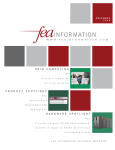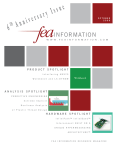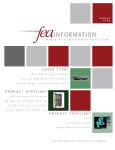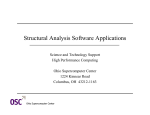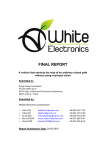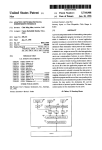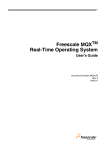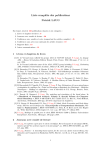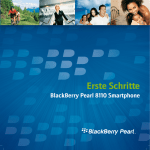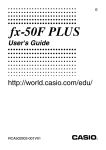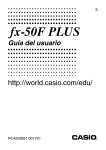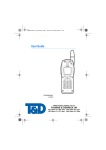Download FEA Newsletter November 2006 - Free of Papers from LS
Transcript
N O V E M B E R 2 0 0 6 I N F O R M AT I O N W W W . F E A I N F O R M A T I O N . C O M S O F T WA R E S P O T L I G H T Fe w PA P E R f r o m o n M e m o r y S e t t i n g s f o r L S - D Y N A SPOTLIGHT R e d u c t i o n c a u s e d “ Wo r d s ” o f b y C r e w I nj u r y A c c e l e r a t i o n M i n e B l a s t / I E D H A R D WA R E S P O T L I G H T I B M R e v s o f N e w F E A U p x 8 6 P e r f o r m a n c e S e r v e r s Q u a d - C o r e w i t h P r o c e s s o r s I N F O R M AT I O N R E S O U R C E M A G A Z I N E FeaInformation.com 1 FEA Information Worldwide Participants 01 02 03 06 10 11 13 14 18 19 20 21 27 28 30 31 32 34 35 Index FEA Announcements LS-DYNA® - Reduction of Crew Injury caused by Acceleration from Mine Blast/ IED – Ala Tabiei and Gaurav Nilakantan A Few “Words” on Memory Settings for LS-DYNA – Suri Bala AMD Shop Servers including IBM – HP IBM Press Release –Performance of x86 Servers with New Quad-Core Performance LS-PrePost® Yahoo Yammerings FEA Weekly News Page – October Highlights LSTC Training Classes EVENTS LS-DYNA Resource Page Hardware & Computing and Communication Products Software Distributors Consulting and Engineering Services Educational & Contributing Participants China Participants Informational Websites Resume Posting Editor: Art Shapiro Managing Editor: Marsha Victory Graphic Designer: Wayne L. Mindle Technical Writers: Dr. David Benson Uli Franz Dr. Ala Tabiei Suri Bala Technical Consultants: Steve Pilz - Reza Sadeghi FeaInformation.com FEA Information Announcements FEA News: Our Editor, Trent Eggleston, is relocating and we wish him well in his new career. I would like to take this opportunity to welcome Art Shapiro in his new role as Editor of FEA Information Worldwide News. Art Shapiro has been our Technical Editor for the news, Editor of Heat Transfer Analysis, and well known in the engineering community for his developments, publications, and worldwide training on Thermal Analysis. Industry News: LSTC announced a direct distributor of LS-DYNA, LS-OPT, LS-PrePost in Israel. McKit Systems Ltd. 7 Martin Gahl St., Kiryat-Arie Petach-Tikva 49512 – Israel For LS-DYNA Sales and Information Contact: Tal Geldman - McKit Systems Ltd. - Co-Director Sales & Marketing Tel: +972-3-9278573 - Cell:+972-52-3878573 e-Mail: [email protected] www.mckit.co.il LSTC Michigan’s Office: LSTC’s Michigan Office has expanded in development, training and local support to the automotive industry. Therefore, starting in 2007 FEA Information News will carry a separate page for LSTC Michigan’s office training and news. Sincerely, Art Shapiro [email protected] Marsha J. Victory [email protected] The content of this publication is deemed to be accurate and complete. However, FEA Information Inc. doesn’t guarantee or warranty accuracy or completeness of the material contained herein. All trademarks are the property of their respective owners. This publication is published for FEA Information Inc., copyright 2006. All rights reserved. Not to be reproduced in hardcopy or electronic copy. Note: All reprinted full articles, excerpts, notations, and other matter are reprinted with permission and full copyright remains with the original author or company designated in the copyright notice 2 FeaInformation.com 3 LS-DYNA Publication Complete Paper is located at: www.feapublications.com sidebar link showcased Abstract & Excerpt Reduction of Crew Injury Caused by Acceleration From Mine Blast/ IED © Copyright Ala Tabiei ([email protected]) and Gaurav Nilakantan Abstract Anti tank (AT) mines pose a serious threat to the occupants of armored vehicles. High acceleration pulses are transmitted to the occupant through vehicle-occupant contact interfaces, such as the floor and seat, posing the risk of moderate injury to fatality. The use of an energy absorbing seat in conjunction with vehicle armor plating greatly improves occupant survivability during such an explosion. The axial crushing of aluminum tubes over a steel rail constitutes the principal energy absorption mechanism to reduce the blast pulse transmitted to the occupant in this investigation. The explicit non-linear finite element software LS-DYNA© is used to . perform all numerical simulations. The second part of this investigation simulates the impact of an occupant’s foot by a rigid wall whose upward motion is comparable to an armored vehicle’s reaction to a mine blast directly underneath it. Data such as hip and knee moment, femoral force, and foot acceleration are collected from the dummy and compared to injury threshold values from various references. Finally, a simple numerical formulation is presented, to predict the acceleration response during dynamic axial crushing of cylindrical tubes. The formulation uses an energy balance approach and is coded in the high level language MATLAB© Figure 1. A solider subjected to mine blast/IED FeaInformation.com Energy Absorbing Seat Structure Axial crushing of cylindrical tubes became a very popular choice of impact energy absorber because it provides a reasonably constant operating force, has high energy absorption capacity and stroke length per unit mass. Further a tube subjected to axial crushing can ensure that all of its material participates in the absorption of energy by plastic work. It has been reported that the concertina mode of deformation results in a higher specific energy absorption than the diamond mode of deformation (high D/t ratios, non-axisymmetric). The EA seat structure with a Hybrid III dummy is displayed in Figure 1. The support structure rigidly holds two cylindrical steel rails inclined at a 20° angle to the vertical. A set of upper and lower cylindrical brackets which slide along the rails are attached to the seat. A steel collar is rigidly attached to each rail. The aluminum crush tubes are coaxial with the steel rails and are positioned between the upper bracket and collar. As the upper bracket moves downwards, it crushes the aluminum tubes against the collar, which is the primary energy absorption principal used here. The occupant is modeled using a 5th percentile HYBRID III dummy. An initial time delay of 50 ms in all simulations allows for gravity settling of the dummy against the seat to ensure proper contact. In addition to the aluminum crush tubes, further energy absorbing elements are added to the design. A foam cushion provides additional cushioning to the occupant. The cushion behind the dummy’s neck and head is made thicker so as to minimize the head recoil distance before impact with the cushion. An airbag cushion whose inflation is controlled by a sensor that triggers at a user defined acceleration level provides additional cushioning, especially during vehicle slam down after a mine blast. The infla- 4 tion of the airbag is controlled in LS-DYNA using a user defined load curve. A SIMPLE_AIRBAG model in LSDYNA has been used. The applied pulses prescribe structural accelerations that correspond to actual physical phenomenon. Figure 2(a) displays the deceleration pulse that represents vertical impact after freefall, based on data from. Figure 2(b) displays the acceleration pulse that represents a mine blast under an armored vehicle. This pulse includes a peak acceleration of 180 G for a 5 ms duration. This is followed by a 85 ms duration of negative acceleration to put the final velocity at zero and final displacement at its maximum vertical position. After that the acceleration stabilizes at -1 G (freefall) until displacement is zero. A series of vertical drop test simulations are run using LSDYNA. Numerical data such as seat and torso accelerations are compared to experimental data. A series of mine blast simulations are then run using LSDYNA. Occupant data such as head and neck accelerations, neck flexionextension moments, seat and torso accelerations, are collected and examined to assess occupant injury and survivability. Injury assessment during lower leg impact During the explosion of an AT (anti tank) mine under an armored vehicle, significant impulse loads are transmitted to the occupant through the vehicle-occupant interfaces such as the floor and seat. If these loads are not attenuated to survivable levels, it normally leads to fatality of the occupant. The impact of the vehicle structure with the occupant’s feet through the floor and other contact points such as pedals and foot rests, and corresponding extremely high acceleration pulse transmitted can result in fracture and disinte- FeaInformation.com gration of the femoral bone, ultimately even fatality. The impact of lower leg during a mine blast under an armored vehicle has been numerically simulated using a 50th percentile HYBRID III dummy to better understand the effect of the mine blast on occupant survivability and injury assessment, as well as to validate the use of a HYBRID III dummy in such applications. Further the high cost associated with destructive testing is avoided. The experimental set up formed the basis for the numerical simulation and is displayed in Figure 3. A seat is rigidly fixed in 3-d space. The occupant is simulated by a 50th percentile HYBRID III dummy which is internally created by LSDYNA during the initialization of the simulation run. The dummy is seated on this rigid seat. The position and orientation of the arms is not important and is therefore left at its default values, as it plays no role during the simulation. Similarly an occupant restraint mechanism such as a seatbelt has not been modeled as there is no significant middle or upper torso movement during the simulation. The main region of activity lies between the foot and hip of the dummy. A rigid horizontal wall simulates the impacting vehicle floor. The motion of the floor is controlled by prescribing its velocity. While modeling the wall, care is taken to position the wall as close as possible to the feet, as even the smallest gap between the wall and feet can significantly alter extracted data such as femur axial compressive force. Since it is not possible during modeling to ensure 5 exact contact, gravity is applied during the initial time lag which ensures the feet initially settles against the floor. As the feet are thrown upwards during the application of the input prescribed velocity pulse to the wall, data such as foot acceleration, lower leg acceleration, hip moment, knee moment and femur axial compressive force are measured. Filtering of data is done with a low range Butterworth filter, with a cut-off frequency at 300 Hz. The data is then compared to reference values to assess injury. Numerical Results and Discussion Vertical Drop Tests with HYBRID III Dummy The peak deceleration pulse has been attenuated from 76 G to 9 G at the lower torso, as displayed in Figure 4. This is well within the injury criteria limit of 17.5 G. According to the resultant head acceleration tolerance limit is 150 G in a 2 ms interval. The contoured foam cushion behind the head ensures that the head is supported at all times during the simulation, so that there is no possibility of injury occurring from the head acceleration criteria. The peak dynamic crushing force of both aluminum tubes is 14300 N. However the compressive lumbar load experienced by the dummy is just 3600 N which is well below the lumbar load criterion of 6672 N. This is attributed to the load attenuation during compression of the foam cushion. Complete Paper is located at: www.feapublications.com sidebar link showcased FeaInformation.com 6 Few “Words” on Memory Settings for LS-DYNA Suri Bala Coyright © 2006 Livermore Software Technology Corporation Introduction: Memory in LS-DYNA is specified in "words" during execution time. The term "word" refers to the amount of data that can be written to or read from a memory in one operation. The following figure will aid in the relationships of bits, the most basic data type, to words on various computers. One bit is a basic unit of data which can be transmitted and can be either 0 or 1. A sequence of 4 bits is called a “Nibble” and a sequence of 8 bits is called as one “Byte”. 16-bits or 2 bytes is equal to one word on a 16-bit computer. 32-bit (or 4 bytes) is equal to one word on a 32-bit computer. 64-bit (or 8 bytes) is equal to one word on a 64-bit computer. FeaInformation.com 7 Maximum memory allocations: The maximum memory that can be allocated depends on the computer architecture. The following table provides a brief overview of the maximum allowable memory that can be allocated based on the addressing type. The following table provides a sample conversion from a RAM memory specified in bytes to equivalent words based on the computer architecture. Please note that for 16-bit addressing, the maximum memory is limited to 65,536 bytes or 32,768 words. Memory setting for SMP LS-DYNA: In Shared Memory Parallel (SMP), multiple CPUs solve a given problem in parallel using shared memory as shown below. To allocate sufficient memory, we can specify "memory=XXX" in the execution line where XXX refers to the size of the memory in words which is shared by all CPUs. FeaInformation.com 8 Memory setting for MPP LS-DYNA: There are two memory values that are used by MPP LS-DYNA. MEMORY_1 (specified using memory=xxx in words at the execution line) is used by the first master processor to decompose the model. MEMORY_2 (specified using memory2=xxx in words) is used by all the processors (including the master processor) to solve the decomposed problem. MEMORY_2 depends on the number of processors used to solve a problem. The more number of processors, the smaller the decomposed model, and consequently, smaller the memory required by each processor. Recommended memory settings for LS-DYNA 1. Set LSTC_MEMORY to AUTO using the environment variable setting. This allows LSDYNA to use the initial memory values and then to dynamically allocate memory if it needs more memory. It must be noted that LSTC_MEMORY option is only applicable for explicit analysis. When running implicit simulations, the user must specify appropriate memory manually based on the model size. 2. Use roughly 30-70% of the total memory available on the master node as MEMORY_1. This initial memory depends on the model size but the goal would be to reduce effort by LS-DYNA to dynamically scale the memory. 3. MEMORY_2 (only for MPP) depends on the number of processors. A good number would be to start with 20-40% of the total memory available on the nodes after which LS-DYNA will then dynamically allocate more memory if required. FeaInformation.com 9 Notes 1. The main memory can be specified either at the command line execution (using memory=XXX words) or in the keyword file (using *KEYWORD XXX). When both forms of definitions exist, memory specified on the command line will overrule all other settings. 2. Memory2 for MPP-LSDYNA can only be specified at the command line execution (using memory2=xxx words). 3. Memory at the command line execution can also be specified in Mega words such as memory=260M which is equivalent to memory=260000000 words. 4. Double precision executables of both SMP and MPP versions of LS-DYNA stores may require more memory than using single precision version. Precision of LS-DYNA version is flagged in the executable name as either ‘s’ (single) or ‘d’ (double) and the information is also output to D3HSP file in the header. 5. When H-Adaptivity is used for shell elements, LS-DYNA re-initializes the model after every adaptive step. New elements created due to adaptivity will require additional memory when compared with earlier initialization steps. This additional memory requirement can be internally allocated by LS-DYNA only when using the AUTO memory option. 6. When using solver switching between implicit and explicit solution type, only one memory size is used for both solution types as specified either in the *KEYWORD or using the command line argument. Since AUTO memory is not supported for implicit solution type, it is important to set the maximum memory requirement as required by the implicit solution type. Acknowledgements Dr. Brian Wainscott Dr. Jason Wang Dr. Morten Jensen Mr. Jacob Krebs (for performing his magic on my image drafts) Marsha Victory Some useful links 1. http://www.learn-c.com/data_lines.htm 2. http://cnx.org/content/m13082/latest/ 3. http://www.cs.rpi.edu/~hollingd/comporg/notes/datarep/datarep.pdf FeaInformation.com 10 AMD SHOP SERVERS FEA Information Participant’s Listed (Complete List is on the AMD website) http://shop.amd.com/us-en/platforms/4.aspx Based on the 64-bit AMD Opteron™ processor, these servers offer unprecedented power, performance, flexibility, and reliability. BladeCenter LS20 - IBM from $3,449.00 • AMD Opteron™ Processor • Hard Drive: 0GB • Included Memory: 2048MB HP ProLiant DL385 G2 1.8GHz- Rack Server - Hewlett-Packard from $2,768.00 • Dual-Core AMD Opteron™ Processor • Hard Drive: 0GB • Included Memory: 1024MB Tyan Transport GX28 (B2881) with ATI graphics card - Colfax International from $1,800.00 • AMD Opteron™ Processor • Hard Drive: 0GB • Included Memory: 0MB HP ProLiant DL385 2.4GHz/1M, Dual Core - Rack Server - Hewlett-Packard from $2,439.00 • Dual-Core AMD Opteron™ Processor • Hard Drive: 0GB • Included Memory: 1024MB HP ProLiant DL385 2.8GHz/1GHz, 1M, 1GB Rack Server - Hewlett-Packard from $2,549.00 • AMD Opteron™ Processor • Hard Drive: 0GB • Included Memory: 1024MB HP ProLiant BL35p Dual Core 2.2GHz/1M, 2P Server Blade - Hewlett-Packard from $3,600.00 • Dual-Core AMD Opteron™ Processor • Hard Drive: 0GB • Included Memory: 2048MB FeaInformation.com 11 November: Participant Press Release: Reprinted with Permission (full contents can be read at IBM) IBM Revs Up Performance of x86 Servers With New Quad-Core Processors New Servers Feature Balanced System Design to Optimize Quad-Core Performance ARMONK, NY - 09 Nov 2006: IBM (NYSE: IBM) announced today that it is enhancing its line of x86 servers with the introduction of four, quad-core IBM systems and a new blade utilizing the quad-core Intel Xeon 5300 processor. System x™ servers provide a whole new level of value for clients, delivering three to four times performance of systems that IBM offered less than 12 months ago, enhanced systems management capabilities, expanded memory and I/O. When combined with the built-in virtualization and power management from IBM, these new systems enable clients to consolidate applications onto fewer, more powerful servers and keep control over energy spending in the datacenter. "The introduction of quad-core processors to the industry further drives the need for innovative server designs so that clients can take full advantage of the new capability, and at the same time it's also accelerating the need for clients to virtualize their infrastructure to simplify and get the most out of these systems," said Jim Gargan, vice president and business line executive, IBM System x. "With our strong portfolio of knowledge, products and tools, IBM is uniquely positioned to help clients realize the power of quad-core processors so they can do more with less." IBM's x3650 packs up to 33 percent more memory and I/O than Dell's PowerEdge 2950, which reduces communication bottlenecks and optimizes performance (1). Together, memory and I/O keep each processor fed with data so that compute workloads can be executed at top speeds on all four cores. The SPECint_rate benchmark comparing System x3650 with the quad core processors to the System x3650 with dual core processors reported a 64 percent performance improvement by the system with quad core processors. (2) To leverage the new performance capability of multicore servers, many customers will move to virtualization solutions to run multiple applications per server. The new System x servers support virtualization solutions such as VMWare, and come with virtualization sizing tools to make it even easier for clients to deploy virtualization in their environment. With the integration of IBM Virtualization Manager into new IBM Director 5.2, IBM enables clients to manage from a single console both physical and virtual machines for VMware, Microsoft Virtual Server, and Xen environments on IBM System x and BladeCenter®. IBM Director 5.2 systems management software also features easy express installation for small and medium businesses, better firmware and driver management. IBM PowerExecutive™, one of the first solutions in the industry that provides customers with the intelligence needed to effectively manage power consumption in the datacenter, is also available on Systems x3650, x3550 and BladeCenter HS21 introduced today, at no extra FeaInformation.com charge and available by download for customers. System Details x3650: Stable business-critical application 2U, two socket rack server suitable for medium and large enterprises datacenter environments; Starting at U.S. $2,419* 12 Starting at U.S. $2,369*. x3500: Stable business-critical application two socket tower server; Starting at U.S. $ 2,189*. x3400: Affordable performance for growing business; targeted for small and medium businesses, remote/branch offices or retail Starting at U.S. $1,839*. x3550: 1U, two socket rack server provides Application density for power managed data centers; suitable for medium and large enterprises datacenter environments; BladeCenter HS21: Delivers leadership performance efficiency in a smarter blade form factor; Starting at U.S. $3,049*. Clients can order quad-core systems beginning Tuesday, November 14, with volume shipping expected to begin in December for the system x3550 and x3650, and in January for the x3400, x3500 and the BladeCenter HS21 FeaInformation.com 13 LS-PrePost® Online Documentation News Update www.lstc.com/lspp © Copyright LSTC Online documentation is provided by the developers of LS-PrePost and is continually updated. LS-PrePost, as well as LS-OPT are delivered with LS-DYNA at no additional fees. LS-PrePost is an advanced pre and post-processor. The user interface is designed to be both efficient and intuitive. LS-PrePost runs on Windows, Linux, and Unix utilizing OpenGL graphics to achieve fast rendering and XY plotting. What’s New in LS-PrePost October 17 - Updated SCRIPTO API Resources October 18 - Tutuorial 12: Introduction to curves and surfaces. Topics covered: Curve create / join / sweep mesh / n-line mesh / part trim Surface create / mesh October 25 - Tutorial 13: Explicit to eigenvalue to implicit conversion. Topics covered: Explicit to eigenvalue analysis conversion Eigenvalue to implicit analysis conversion October 26 - Update of Configuration File information October 30 - Tutorial 14: Introduction to the ElGen Interface. Topics covered: Generate shells by Solid Face / Solid Surface Generate solids by Shell Offset / Shell Drag / Between Shell Layers November 05 - Tutorial 15: Introduction to various Page 1 post-processing tools Topics covered: Follow, Trace, Anno, SPlane, Vector, Fcomp, Range, Blank, History, Model FeaInformation.com 14 Yahoo Group Yammerings Note: LS-DYNA Yahoo Group is neither owned nor operated by LSTC, and LSTC does not control the content. Jim Kennedy KBS2 Inc. [email protected] Len Schwer Schwer Engineering & Consulting Services [email protected] The LS-DYNA Yahoo Group archives contains a wealth of information that can be helpful to any LS-DYNA user. We suggest you review the archives when you are seeking help on any topic related to LS-DYNA. This installment of “Yahoo Yammerings” features five questions, with responses, from the past month of postings to the LS-DYNA Yahoo Group. 1. 2. 3. 4. 5. Sliding Interface Energy? LS-PrePost 2.1? Fluid structure and temperature? Reinforced concrete model for impact problems? Non-local Material? Question: LS-PrePost 2.1? I had questions regarding LS_Prepost2.1. First can anyone tell me where i can find the manual for LS-PrePost? Second, I am trying to use set option in LS-PrePost 2.1 to make a set of nodes and elements. But I have to choose each node for the node_set and similarly four nodes for the element. I have over 1000 elements and it is a very long process. Is there any option of selecting elements by area, or by region like the option we had in FEMB. Reply by Yathiraj This is a good online documentation with tutorials as well. http://www.lstc.com/lspp/content/pages.shtml Reply by Katie Cook In answer to your second question: yes there is a very nice feature in LS-PrePost that can create node sets (or other types of sets as well). Go to Page 5>SETD>create, then in the bottom center of your screen, below graphics window, there are many options for selection. To select all nodes on an area, your best bet is to select ByElem then check box for Prop (propagate). The default angle (Ang) is 5 degrees. Try different angle values to go around corners or over contours. Once you have set FeaInformation.com 15 all the buttons, then just click on an element face on the area of interest, and the selection should propagate over the surface. I also recommend just trying some of the other options to understand what they can do. Hit Apply to create the set. You can output the set to a text file by selecting Show then Write. Or you can add to or remove from your set by selecting Modify. Question: Fluid structure and temperature? 1. When simulating a detonation of HE using an ALE mesh the temperature in the ALE mesh is not very high only 2-3 degrees where I expected more like 2-3000 degrees? I am modeling the explosives with *MAT_HIGH_EXPLOSIVE_BURN and *EOS_JWL, and the pressure history fits perfect. 2. Also I'm coupling a Lagrange meshed steel plate to the ALE mesh (*CONSTRAINED_LAGRANGE_IN_SOLID). How do I get the temperature generated in the ALE mesh to be coupled to the Lagrange mesh. Is it done automatically or will I have to define a structural-thermal analysis? 3. The Steel plate is modeled with a JC material. Does the temperature defined in the JC material model depend on the temperature of the surroundings or is it only calculated from internal work. Response by Jim Kennedy Perhaps Archived Message #7569 (given below for your convenience) might provide some comments of interest. Message #7569 19 Dec 2005 by James Kennedy: Consider modeling your problem using Lagrangian solids. Then you can run it as a coupled thermal-mechanical problem (set SOLN=2 on *CONTROL_SOULTION). Contact frictional heating is turned on by setting FRCENG=1 on the *CONTROL_CONTACT keyword. The Johnson-Cook model can be used in a mechanical only problem or in a coupled thermal-mechanical problem. 1) Mechanical only - Adiabatic heating is calculated if you enter a value for specific heat CP on the *MAT_JOHNSON_COOK keyword. Temperature change is calculated by dividing the plastic work by (rho)*(cp). This temperature change is used in calculating T* (see user manual). The temperature is not dumped to d3plot. 2) Coupled thermal-stress - The heat capacity defined on the *MAT_THERMAL material keyword is used in calculating the temperature change resulting from plastic work. The temperature is dumped to d3plot (use Fcomp, Misc, temperature). Heat conduction is turned on but is usually very small based on the time scale of impact problems. Question: Reinforced concrete model for impact problems? FeaInformation.com 16 Can any one please supply me with a concrete model (including EOS?). I’m trying to simulate impact of projectile into reinforced concrete at mach 1 and above. If possible, can I have the model in SI units, may be in ‘g, cm and microseconds’. Response by Len Schwer I suggest you have a look at Mat072R3 (*MAT_CONCRETE_DAMAGE_REL3) available in Version 971. This model requires only the unconfined concrete strength, and density. It may be used with any consistent set of units. There is some explanation and a demonstration of the model's ability to represent concrete behavior on the following web site: http://www.geomaterialmodeling.com/ Question: Angular velocity of INITIAL_VELOCITY_GENERATION? I tried to add angular velocity to some element but I got confused by the definition of the keyword--INITIAL_VELOCITY_GENERATION. On Card 2, the xc, yc, zc, nx, ny, nz, phase, could someone explain the meaning of these and give a simple example? Response by Amrit Lal xc, yc ,zc are the coordinates of the node about which you want to prescribe an angular velocity, and nx, ny, nz is the unit vector along the axis of rotation. Suppose you want to give angular velocity with respect to point A( 10,20,30) and the axis of rotation is x axis than define following things: xc=10, yc=20, zc=30 and nx=1. Question: Non-local Material? I want to use the non-local capability of LS-DYNA and incorporate it in my user-defined material model. Does anybody have any experience of using the non-local model or know any related document about it? Response by Len Schwer Two points: #1 - There are two references provided in the LS-DYNA User Manual related to Mat_NonLocal: Worswick & Lalbin [1999] and Pijaudier-Cabot Bazant [1987]. If you are not familiar with these references you might want to start with these “related documents.” #2 - Mat_NonLocal has NOT been implemented for ALL material models, and this apparently includes Mat_User_Defined; see the outdated list of material models on Page 23.25(MAT) [page 1053 of 2209] in the Version 971 User Manual. I suggest you contact your LSTC support and request Mat_NonLocal be implemented for Mat_User_Defined. Once this has been done, your user material model would store the quanity to be averaged via Mat_NonLocal in the effective plastic strain location. FeaInformation.com 17 LS-DYNA Yahoo Groups There are over 2000 subscribers from all over the world, and this list seems to grow by a hundred new subscribers ever few months; no small testament to the rapidly growing popularity of LS-DYNA. The group currently averages about 200 message per month, i.e. about 7 message per day. You can subscribe to the group by sending an email request to [email protected] or by visiting the Yahoo Groups web site http://groups.yahoo.com Generally, the quickest/best responses are to those questions posed with the most specifics. General questions such as “How do I use XXX feature?” either go unanswered, or are answered by Jim Kennedy with links to appropriate references in the growing LS-DYNA related literature, e.g. see the archive of LS-DYNA Conference proceedings at www.dynalook.com FeaInformation.com 18 Previous Month – October Weekly News Page Highlights Review Complete Product/Service information can be found on the respective company website. Information is copyright to the respective listed companies AMD: The Japan Research Institute, Ltd JMAG-Studio is an electromagnetic field analysis software package developed by JRI Solutions, Ltd. (JRI-SOL) that supports the design and development of motors, actuators, circuit components, antennas and other electric and electronic products. It has been supported and used by many companies and universities since 1983. JMAG has a long track record of use for analyzing motors and other rotating devices ANSYS, Inc. The upcoming releases of its multiphysics simulation software - ANSYS(R) 11.0 and FLUENT(R) 6.3 - will include support for Microsoft Windows Compute Cluster Server 2003 Intel: Hewlett Packard The new Dual-Core Intel® Itanium® 2 processor delivers more reasons than ever to migrate your most demanding applications off RISC and mainframe systems and onto cost-effective Intel® technology-based servers . FeaInformation.com LSTC Training Classes: 19 Nov– Dec 2006 Classes The California office training center accommodates 23 students. The Michigan office has capacity for 12 students. Classes are scheduled throughout the year at both locations. For the most current schedule visit 116Hwww.lstc.com Onsite training is also available. Training Class US $ Advanced LS-DYNA for Impact Analysis $950 Advanced Options in LS-DYNA $750 ALE/Eulerian & Fluid/Structure Interaction in LS-DYNA $750 Concrete and Geomaterial Modeling with LS-DYNA $750 Contact in LS-DYNA $750 Introduction to LS-DYNA $750 Introduction to LS-OPT $750 LS-DYNA Composite Materials $750 LS-DYNA Implicit $750 LS-DYNA for Heat Transfer & Thermal-Stress Problems $500 Material Modeling Using LS-DYNA User Defined Options $750 MESH Free Methods in LS-DYNA (SPH and EFG) $750 Livermore, CA Nov. 14-17 Nov. 07-10 Detroit, MI Dec. 11-14 FeaInformation.com EVENTS – 2006 If you want your event listed please send the information to: [email protected] 2007 May 28-29 6th European, Sweden July 23-26 Ninth US National Congress on Computational Mechanics, San Francisco, CA - USNCCM-IX October 1112 LS-DYNA Users Meeting - Germany - hosted by DYNAmore October 3031 Japan LS-DYNA Users Conference 2007 - hosted by JRI 2008 June 8-10 8th International Users Conference, Dearborn, MI, US 20 FeaInformation.com 21 LS-DYNA Resource Page Interface - Hardware - OS And General Information Participant Hardware/OS that run LS-DYNA (alphabetical order). LS-DYNA has been fully QA’d by Livermore Software Technology Corporation for All Hardware and OS listed below. TABLE 1: SMP TABLE 2: MPP Interconnect and MPI TABLE 1: SMP - Fully QA’d by LSTC AMD Opteron Linux FUJITSU Prime Power SUN OS 5.8 FUJITSU VPP Unix_System_V HP PA-8x00 HP-UX 11.11 and above HP IA-64 HP-UX 11.22 and above HP Opteron Linux CP4000/XC HP Alpha True 64 IBM Power 4/5 AIX 5.1, 5.2, 5.3 IBM Power 5 SUSE 9.0 INTEL IA32 Linux, Windows INTEL IA64 Linux INTEL Xeon EMT64 Linux NEC SX6 Super-UX SGI Mips IRIX 6.5 X SGI IA64 SUSE 9 with ProPack 4 Red Hat 3 with ProPack 3 FeaInformation.com 22 LS-DYNA Resource Page MPP Interconnect and MPI FEA Information Inc. Participant’s (alphabetical order) Fully QA’d by Livermore Software Technology Corporation TABLE 1: SMP - Fully QA’d by LSTC AMD Opteron Linux FUJITSU Prime Power SUN OS 5.8 FUJITSU VPP Unix_System_V HP PA-8x00 HP-UX 11.11 and above HP IA-64 HP-UX 11.22 and above HP Opteron Linux CP4000/XC HP Alpha True 64 IBM Power 4/5 AIX 5.1, 5.2, 5.3 IBM Power 5 SUSE 9.0 INTEL IA32 Linux, Windows INTEL IA64 Linux INTEL Xeon EMT64 Linux NEC SX6 Super-UX SGI Mips IRIX 6.5 X SGI IA64 SUSE 9 with ProPack 4 Red Hat 3 with ProPack 3 FeaInformation.com 23 TABLE 2: MPP Interconnect and MPI Vendor AMD Opteron O/S HPC Intereconnect MPI Software Linux InfiniBand (SilverStorm), MyriCom, QLogic InfiniPath LAM/MPI, MPICH, HP MPI, SCALI FUJITSU Prime SUN OS 5.8 Power FUJITSU VPP Unix_System_V HP PA8000 HPUX HPIA64 HPUX HP Alpha True 64 IBM Power 4/5 AIX 5.1, 5.2, 5.3 IBM Power 5 SUSE 9.0 INTEL IA32 Linux, Windows INTEL IA64 Linux INTEL Xeon EMT64 Linux NEC SX6 Super-UX SGI Mips IRIX 6.5 SGI IA64 SUSE 9 w/ProPack 4 NUMAlink, InfiniBand, (VolRedHat 3 w/ProPack taire) 3 LAM/MPI InfiniBand (Voltaire), MyriCom LAM/MPI, MPICH, HP MPI, SCALI LAM/MPI, MPICH, HP MPI InfiniBand (Topspin, Voltaire), MyriCom, QLogic InfiniPath LAM/MPI, MPICH, HP MPI, INTEL MPI, SCALI NUMAlink MPT MPT, Intel MPI, MPICH FeaInformation.com 24 LS-DYNA Resource Page - Participant Software Interfacing or Embedding LS-DYNA Each software program can interface to all, or a very specific and limited segment of the other software program. The following list are software programs interfacing to or having the LS-DYNA solver embedded within their product. For complete information on the software products visit the corporate website. ANSYS - ANSYS/LS-DYNA ANSYS/LS-DYNA - Built upon the successful ANSYS interface, ANSYS/LSDYNA is an integrated pre and postprocessor for the worlds most respected explicit dynamics solver, LS-DYNA. The combination makes it possible to solve combined explicit/implicit simulations in a very efficient manner, as well as perform extensive coupled simulations in Robust Design by using mature structural, thermal, electromagnetic and CFD technologies. AI*Environment: A high end pre and post processor for LS-DYNA, AI*Environment is a powerful tool for advanced modeling of complex structures found in automotive, aerospace, electronic and medical fields. Solid, Shell, Beam, Fluid and Electromagnetic meshing and mesh editing tools are included under a single interface, making AI*Environement highly capable, yet easy to use for advanced modeling needs. ETA – VPG Streamlined CAE software package provides an event-based simulation solution of nonlinear, dynamic problems. eta/VPG's single software package overcomes the limitations of existing CAE analysis methods. It is designed to analyze the behavior of mechanical and structural systems as simple as linkages, and as complex as full vehicles MSC.Software - MSC.Dytran LS-DYNA Tightly-integrated solution that combines MSC.Dytran's advanced fluid-structure interaction capabilities with LS-DYNA's high-performance structural DMP within a common simulation environment. Innovative explicit nonlinear technology enables extreme, short-duration dynamic events to be simulated for a variety of industrial and commercial applications on UNIX, Linux, and Windows platforms. Joint solution can also be used in conjunction with a full suite of Virtual Product Development tools via a flexible, cost-effective MSC.MasterKey License System. ETA – DYNAFORM Includes a complete CAD interface capable of importing, modeling and analyzing, any die design. Available for PC, LINUX and UNIX, DYNAFORM couples affordable software with today's high-end, low-cost hardware for a complete and affordable metal forming solution. Side Impact With Fuel Oil Inside FeaInformation.com 25 MSC.Software - MSC.Nastran/SOL 700 The MSC.NastranTM Explicit Nonlinear product module (SOL 700) provides MSC.Nastran users the ability access the explicit nonlinear structural simulation capabilities of the MSC.Dytran LS-DYNA solver using the MSC.Nastran Bulk Data input format. This product module offers unprecedented capabilities to analyze a variety of problems involving short duration, highly dynamic events with severe geometric and material nonlinearities. MSC.Nastran Explicit Nonlinear will allow users to work within one common modeling environment using the same Bulk Data interface. NVH, linear, and nonlinear models can be used for explicit applications such as crash, crush, and drop test simulations. This reduces the time required to build additional models for another analysis programs, lowers risk due to information transfer or translation issues, and eliminates the need for additional software training. MSC.Software – Gateway for LS-DYNA Gateway for LS-DYNA provides you with the ability to access basic LS-DYNA simulation capabilities in a fully integrated and generative way. Accessed via a specific Crash workbench on the GPS workspace, the application enhances CATIA V5 to allow finite element analysis models to be output to LS-DYNA and then results to be displayed back in CATIA. Gateway for LS-DYNA supports explicit nonlinear analysis such as crash, drop test, and rigid wall analysis. Gateway products provide CATIA V5 users with the ability to directly interface with their existing corporate simulation resources, and exchange and archive associated simulation data. FeaInformation.com 26 Oasys software for LS-DYNA Oasys software is custom-written for 100% compatibility with LS-DYNA. Oasys PRIMER offers model creation, editing and error removal, together with many specialist functions for rapid generation of error-free models. Oasys also offers post-processing software for in-depth analysis of results and automatic report generation. EASi-CRASH DYNA • EASi-CRASH DYNA is the first fully integrated environment for crashworthiness and occupant safety simulations with LSDYNA, and covers the complete CAEprocess from model building and dataset preparation to result evaluation and design comparisons. EASi-CRASH DYNA can be used for concept crash, FE crash and coupled rigid body/FE crash simulations in conjunction with MADYMO. EASi-CRASH DYNA’s main features include: • Support of all keywords of LS-DYNA 970/971 • Powerful mesh editing features, such as automesh and remesh • LS-DYNA/MADYMO coupling capabilities for pre- and post processing • Model Assembler for organizing the model through sub assembly/sub models and included files • • • • • • Enhanced Weld tools for manipulation of connections and Weld comparison Simple dummy positing and seat belt routing Pre and Post processing in same environment Superpose and merge multiple models Animation and plotting Process compatible Full capability to handle IGES, CATIA V4, CATIA V5, UG and NASTRAN files FeaInformation.com Hardware - Computing - Communication Products Logo’s hyperlink to company’s website 27 FeaInformation.com Software Distributors Alphabetical order by Country Australia Canada China China China Germany Germany India Italy Italy Japan Japan Japan Korea Korea Leading Engineering Analysis Providers Metal Forming Analysis Corporation ANSYS China Arup MSC. Software – China CAD-FEM DynaMore Altair Engineering India Altair Engineering Italy Numerica SRL Fujitsu Limited The Japan Research Institute CRC Solutions Corp. Korean Simulation Technologies Theme Engineering 28 FeaInformation.com 29 Software Distributors (cont.) Alphabetical order by Country Netherlands Infinite Simulations Sysbems B.V.e Russia State Unitary Enterprise - STRELA Sweden Engineering Research AB Taiwan Flotrend Corporation USA Engineering Technology Associates, Inc. USA Dynamax USA Livermore Software Technology Corp. UK ARUP FeaInformation.com 30 Consulting and Engineering Services Alphabetical Order By Country (direct links will be completed October) Australia Manly, NSW Canada Kingston, Ontario India Bangalore Italy Torino Italy Firenze UK Solihull, West Midlands USA Austin, TX USA Windsor, CA USA Corvallis, OR USA Neenah, WI www.structuretechnology.com Leading Engineering Analysis Providers (LEAP) Greg Horner [email protected] 02 8966 7888 Metal Forming Analysis Corp. Chris Galbraith [email protected] (613) 547-5395 Altair Engineering India Nelson Dias [email protected] 91 (0)80 2658-8540 Altair Italy [email protected] Numerica SRL [email protected] 39 055 432010 ARUP Brian Walker [email protected] 44 (0) 121 213 3317 KBEC L.C Khanh Bui [email protected] (512) 363-2739 SE&CS Len Schwer [email protected] (707) 837-0559 Predictive Engineering George Laird (1-800) 345-4671 [email protected] Structure Incorporated Todd L. Peters (920) 722 7060 [email protected] FeaInformation.com 31 Educational & Contributing Participants Alphabetical Order By Country China Dr. Quing Zhou Tsinghua University India Dr. Anindya Deb Indian Institute of Science Italy Professor Gennaro Monacelli Prode – Elasis & Univ. of Napoli, Frederico II Russia Dr. Alexey I. Borovkov St. Petersburg State Tech. University USA Dr. Ted Belytschko Northwestern University USA Dr. David Benson University of California – San Diego USA Dr. Bhavin V. Mehta Ohio University USA Dr. Taylan Altan The Ohio State U – ERC/NSM USA Dr. Ala Tabiei University of Cincinnati FeaInformation.com 32 FEA Information China Participants Software, Hardware, Training, Consulting, Services Arup China: LS-DYNA sales, support, training Ansys-China, Inc. Arup Beijing Yuntong Forever CPC. Co. Ltd. Name: Li YuQiang Email: [email protected] Tel 021 5396 6633 extn 151 Tel: 86-10-84085558 Website: www.ansys.com.cn Contact: [email protected] Kimbal Virdi Tel: +86 21 5396 6633 Contact: [email protected] Website: www.arup.com/dyna Tel: +86-10-82561200/01/03 Website: http://cpc.ytforever.com Sole Distributor of LINUX NETWORX, INC. (USA) in China Contact: [email protected] Engineering Technology Associates (China) Inc. Martin Ma Tel: + 86-21-64385725 Contact: [email protected] Hewlett-Packard Asia Pacific Ltd. Jerry Huang Tel: +86-10-65645261 Contact: [email protected] IBM China MSC. Software Corp. Ms. Ling WANG Tel: +86-10-6539-1188 x4463 (T/L:901-4463) Website: http://www.ibm.com/cn/ Contact: [email protected] Tel: +86-10-6849-2777 Website: www.mscsoftware.com.cn Contact: [email protected] FeaInformation.com 33 FEA Information China Participants Software, Hardware, Training, Consulting, Services SGI China Carl Zhang Tel: +86 -10 - 65228868 Ext. 3362 Contact: [email protected] Tsinghua University Qing Zhou, PhD. - Professor Department of Automotive Engineering Beijing, 100084, China Zhongfang Information Technology Ltd Larry Liang Tel: +86-21-54973162 Website: http://www.cntech.com.cn Contact: [email protected] Zhong Guo ESI Co., Ltd Yang Xiaojum Phone: +86 (020) 8235 6272 Contact : Yang Xiaojun FeaInformation.com 34 Informational Websites The LSTC LS-DYNA Support site: www.dynasupport.com LSTC LS-DYNA Support Site www.dynasupport.com FEA Informationwebsites www.feainformation.com TopCrunch – Benchmarks www.topcrunch.org LS-DYNA Examples (more than 100 Examples) www.dynaexamples.com LS-DYNA Conference Site www.ls-dynaconferences.com LS-DYNA Publications to Download On Line www.dynalook.com LS-DYNA Publications www.feapublications.com LS-DYNA CADFEM Portal www.lsdyna-portal.com . FeaInformation.com 35 RESUME Posting: Mark Greer 2516 W. Country Bend Drive South Jordan, UT 84095 (801) 254-9354 [email protected] PRODUCT MARKETING Product Positioning Strategy Brand Management Competitive Analysis Fifteen year experienced marketing professional. Proficient market assessment/business development skills. Skilled in the execution of strategic projects across organizational/functional boundaries; strengths in competitive analysis and development of competitive strategies and tactics to achieve marketing objectives. Experienced in product positioning, pricing, promotion and distribution. A selfstarter, marketing professional with a foundation in team management and process improvements. Innovative, flexible, with an ability to adapt to change and stressful situations. Ability to grasp and communicate technical concepts to the business community. PROFESSIONAL EXPERIENCE Alliance Marketing Manager, Linux Networx, Bluffdale, UT: • • • 2004 - Present Developed and managed computer-aided engineering (CAE) and manufacturing (e.g. CFD, FEA) software partner (ISVs) alliances (e.g. ABAQUS, ANSYS, Fluent, LSTC) and joint-marketing programs worldwide. Assessed partner solution offerings and recruited needed technology vendors to strengthen company’s competitive position and appeal in market place; managed integration points between LNXI and ISV initiatives; worked with key LNXI alliances and partners (e.g. ABAQUS, ANSYS, Fluent, LSTC) to develop, position and market value-add solutions within the LNXI product line (e.g. LS/X, LS-1); assisted with application solution research and analysis; solicited field sales for end-user market data for refinement of product requirements; created value propositions for LNXI product collateral/promotional materials to showcase ISV application solutions, Etc. Directed market research and configuration development of a turnkey, desk-side cluster optimized for finite element analysis (FEA) software applications [e.g. NxNastran]. Effort was catalyst for company to penetrate commercial market with standardized, system product offerings. Assisted in the creation and drafting of a reseller agreement for implementation with partners in the resell of LNXI hardware and solutions. Product Marketing Manager, Novell, Inc., Provo, UT: 1999 - 2003 • Created aggressive eDirectory promotional offer against SUN Microsystems and Microsoft directory offerings. Promo quadrupled eDirectory license adoption in one quarter and received media attention in 6 major publications; increased sales by 37%. FeaInformation.com 36 • Executed the product launch of Novell Directory Services (NDS) eDirectory 8.5 and DirXML 1.0 (now known as Novell Identity Manager) software products, developed messaging, managed analyst relations, refined product pricing and positioning, created channel messaging and training materials, etc. Launch resulted in DirXML 1.0 becoming market leader exceeding revenue projections by 34%. Managed team of six individuals in the delivery of Novell’s flagship product through two key launch initiatives; created web strategy, messaging, competitive positioning and promotional evaluation strategy for the successful consolidation and re-launching of NDS for NT and NDS for Solaris/Linux. Effort resulted in 32% increase in brand recognition. Pre-Sales Consultant, NCR, Inc., Dayton, OH: 1997 - 1999 • Demonstrated success in consultative technical sales of NCR data mining / business intelligence solutions. Supported sales force in scalable data warehouse solution offerings, from business discovery to deployment. Responsibilities included customer presentations/product demonstrations, proof-of-concept, benchmarking, RFP proposals, competitive analysis, account planning/strategic analysis, project management, and retail data mining solution support (e.g.affinity & market basket analysis, customer segmentation, site selection, etc.). • Established/directed the retail data mining Community of Interest and associated intranet web site for the education of NCR sales and technical representatives. • Provided Sears corporation with a detailed data mining / business intelligence discovery and recommendation for improved business operational effectiveness. Awarded multi-million dollar deal as a result. Managed Meijer market basket proof-of-concept proposal. Partner Marketing Manager, Unisys, Inc., Salt Lake City, UT: 1995 - 1997 • Managed data warehouse/business intelligence software partners (ISVs) for the Open Parallel Unisys Server program. Assessed market requirements and customer needs to establish solution requirements, and performed product marketing activities including product development, strategic positioning, vendor selection/recruitment, contract negotiation, business case development, product pricing, life cycle planning, and knowledge transfer. • Developed indirect sales program for “proof-of-concept” data mining/knowledge discovery solution. Projected 6-month ROI of $4M. • Planned/executed a joint Unisys – Red Brick data mining/business intelligence seminartargeting Chief Information Officers, which generated 100 $1 million sales leads [89% lead conversion rate] for MPP systems. Channel Marketing Manager, Century Software, Murray, UT: 1994 - 1995 • Developed ISV, VAR and channel partner promotions and demand generation programs; established/maximized relationships with catalog, distributor (e.g. Tech Data, Ingram Micro) and software/hardware developers. • Managed channel audits and mappings for new software releases; administered market development funds; created competitive promo and channel sales training materials. FeaInformation.com 37 • Tracked performance of channel partner programs and targeted/recruited new prospects; worked with volume distributors to increase effectiveness of penetration, awareness and sales programs. Regional Account Manager, Spire Technologies, Orem, UT: 1993 - 1993 • Exceeded quarterly AS/400 sales projections by 20%; submitted product design changes to increase product’s appeal/marketability; developed new AS/400 business accounts. Marketing Manager, ZZ Software Systems, Orem, UT: 1991 - 1993 • Surpassed corporate growth objectives by 15% for sales/profitability through effective planning and directing of market plans and pricing for all software products. 1990 1987 EDUCATION M.B.A. (Marketing) - National University - San Diego, CA B.S. (Marketing) - Brigham Young University - Provo, UT






































